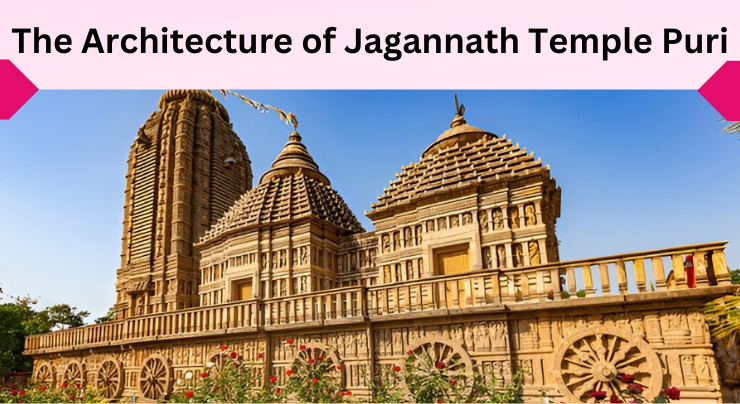The Architecture of Jagannath Temple Puri
The Architecture of Jagannath Temple in Puri, Odisha, is a masterpiece of architectural brilliance and cultural heritage. Built in the Kalinga style of architecture, this iconic temple showcases intricate carvings, towering structures, and unique design elements that have captivated visitors for centuries. In this article, we will delve into the captivating architecture of the Jagannath Temple, exploring its distinct features and intricate details
Thank you for reading this post, don't forget to subscribe!The Main Temple Structure
![]()
The main structure of the Jagannath Temple, known as the “Deula,” stands tall and majestic. Constructed primarily using sandstone and laterite, it reaches a staggering height of about 214 feet. The Deula is a prime example of the Kalinga architectural style, characterized by its curvilinear towers (Sikharas) and richly ornamented facades.
The temple’s Deula is a panchayath (five-part) structure, with each part rising successively higher, culminating in the towering spire. The Deula is divided into four distinct sections: the Bada Deula (main temple), the Jagamohana (assembly hall), the Natamandira (festival hall), and the Bhogamandapa (offering hall).
Vimana and Jagamohana
The Vimana, or sanctum sanctorum, is the heart of the Jagannath Temple. It houses the deities Lord Jagannath, Lord Balabhadra, and Devi Subhadra. The Vimana is a pyramidal tower with multiple tiers, intricately adorned with miniature spires, known as “Urushringas.” The Urushringas add a distinctive visual appeal to the temple’s architecture.
Connected to the Vimana is the Jagamohana, also called the Mukhashala or porch. The Jagamohana serves as the congregation hall for devotees. It features beautiful carvings and elaborate arches, exuding a sense of grandeur and spirituality.
Know More:- Famous Temples in Orisha
![]()
Neelachakra: The Sacred Wheel of Jagannath
The Neelachakra is made from ashtadhatu, a revered alloy consisting of eight metals: gold, silver, copper, zinc, tin, iron, lead, and mercury. The careful balance and methods used to forge this alloy highlight the advanced metalworking skills of ancient Indian craftsmen. The wheel features eight spokes, each representing one of the eight directions, symbolizing the all-encompassing nature of Lord Jagannath. It is notably large and heavy.
Spiritual Importance
The Neelachakra is seen as a representation of Lord Jagannath’s divine essence. Devotees view it as a central point for their prayers and offerings. It is believed that looking at the Neelachakra brings blessings and spiritual growth. It stands as the most sacred symbol of the temple.
Rituals and Customs
A small flag is attached to the Neelachakra and is changed daily by a temple servant, who climbs the shikhara without safety gear, showcasing incredible devotion and skill. The flag’s movement in the wind, regardless of its direction, is seen as a sign of good fortune. The Neelachakra can be seen from afar, serving as a guiding light for devotees.
Metallurgical Wonder
Creating such a large and detailed wheel from ashtadhatu is an impressive feat of ancient metallurgy. The Neelachakra’s durability and resilience against the coastal climate reflect the high quality of its materials and craftsmanship. The methods used to make it have been forgotten over time. Placing such a heavy object atop the temple requires exceptional skill.
The Four Gates (Dwaras) of Jagannath Temple, Puri
The Jagannath Temple in Puri features four gates, known as Dwaras, which serve as more than just entrances; they are symbolic gateways, each aligned with a cardinal direction and rich in spiritual meaning. These gates play a crucial role in the temple’s design and rituals. Here’s a closer look:
Enclosure and Protection
- The temple is encircled by two walls: the outer Meghanada Prachira and the inner Kurma Prachira.
- These walls act as protective barriers, defining the sacred area.
- The four gates are strategically positioned within these walls to manage access to the temple’s inner sanctum.
Singhadwara (Lion Gate) – East
- This is the main entrance, facing east towards the sunrise.
- It is flanked by two large stone lions, which is how it got its name, Singhadwara.
- This gate serves as the primary entry point for pilgrims and is where the chariots start their journey during the Rath Yatra.
- It holds the highest significance among the gates.
Ashwadwara (Horse Gate) – South
- Situated on the southern side, the Ashwadwara is often used for specific rituals and processions.
- Its name is associated with horses and has connections to the deities.
Vyaghradwara (Tiger Gate) – West
- Facing west, the Vyaghradwara is another important entrance.
- The tiger symbolizes strength, and this gate embodies that power.
Hathidwara (Elephant Gate) – North
- Located on the northern side, the Hathidwara is associated with elephants, which are considered auspicious in Hindu culture.
Symbolic Significance
- Each gate symbolizes a different aspect of the spiritual journey and divine energy.
- The cardinal directions carry their symbolic meanings in Hindu cosmology.
- These gates also regulate the movement of people in and out of the temple.
- Additionally, they are connected to the four Vedas.
Sculptures and Carvings
The Jagannath Temple is renowned for its exceptional sculptures and carvings, which adorn its walls and pillars. The temple’s exterior walls depict scenes from Hindu mythology, epics such as the Ramayana and Mahabharata, and stories from the Puranas. Intricate carvings of deities, celestial beings, animals, and floral motifs create a visual feast for visitors.
The carvings narrate tales of divine incarnations, cosmic battles, and acts of devotion. The skilled craftsmen have brought these stories to life through their artistry, showcasing their deep understanding of mythology and their ability to transform stone into works of art.
Torana Gates
The entrances to the Jagannath Temple are marked by magnificent torana gates, also known as “Mukhasalas.” These toranas serve as ceremonial gateways, welcoming devotees into the temple complex. The torana gates feature intricate carvings of gods, goddesses, celestial beings, mythical creatures, and geometric patterns.
The carvings on the toranas depict episodes from Hindu mythology and symbolize auspiciousness and spiritual significance. The torana gates not only showcase the architectural skills of the craftsmen but also provide a glimpse into the rich cultural heritage of Odisha.
Beams and Pillars
Inside the Jagannath Temple, one can marvel at the intricately carved beams and pillars. The Rangamandapas, or decorative beams, are adorned with exquisite floral motifs, mythical creatures like Gandharvas and Apsaras, and scenes from religious texts. These carvings display a high level of craftsmanship and attention to detail.
The pillars within the temple are equally impressive, both structurally and artistically. They provide support to the temple’s architecture while showcasing intricate carvings of gods, goddesses, and divine beings. The pillars not only serve as functional elements but also add aesthetic charm to the temple’s interiors.
Konark Influence
The architecture of the Jagannath Temple bears influences from the famous Sun Temple of Konark, another architectural marvel in Odisha. The elaborate carvings, the use of stone, and the overall grandeur reflect the stylistic similarities between the two temples. The association with Konark further elevates the significance of the Jagannath Temple in terms of architectural excellence.
Flag Post (Dhvaja Stambha)
A prominent feature within the temple complex is the Dhvaja Stambha, the flag post. Made of wood or metal, the Dhvaja Stambha is a symbol of victory and divine presence. It is adorned with decorative carvings and often features a flag that signifies the presence of Lord Jagannath. The Dhvaja Stambha adds to the grandeur and spiritual aura of the temple.
Temple Complex
The complex contains many smaller shrines for different deities and mandapas (halls) for rituals and gatherings. The kitchen, one of the largest in the world, consists of several structures where Mahaprasad is made.
Intricate Carvings
The temple walls feature detailed carvings that illustrate scenes from Hindu mythology, various deities, and intricate floral and geometric designs. These artworks highlight the remarkable talent of the artisans who constructed the temple, showcasing their detailed artistic skills.
Engineering Marvels
The construction of the temple reflects impressive engineering abilities for its time. The careful arrangement of stones, the design of the shikhara, and elements like the Neelachakra and the flag reveal a deep understanding of architecture and engineering. Additionally, the kitchen’s cooking system, which uses stacked pots, exemplifies practical engineering in everyday use.
Conclusion
The Jagannath Temple in Puri is a testament to the architectural genius and spiritual devotion of its creators. The temple’s Kalinga style of architecture, with its towering structures, intricate carvings, and symbolic design elements, mesmerizes visitors and instills a sense of awe and reverence. The Jagannath Temple stands as a glorious embodiment of Indian temple architecture, captivating the hearts and minds of devotees and art enthusiasts alike.
To know more about the Jagannath Temple Puri, visit these links:
Jagannath Temple Puri: History, Significance, Facts – All You Want To Know
Must Read:
History of Jagannath Temple
Puri Jagannath temple timings: Opening time, Darshan time and Bhog time
Lesser Known Facts About Jagannath Temple
श्री जग्गनाथ आरती – चतुर्भुज जगन्नाथ
Connecting Faith Across Continents: Top 10 Jagannath Temples Outside of India
Top 10 Jagannath Temples In India
Top 10 temples in Puri, Odisha
Frequently Asked Questions About The Architecture of Jagannath Temple Puri
Q1. What is the architectural style of the Jagannath Temple in Puri?
Ans. The Jagannath Temple features Kalinga architectural style, characterized by intricate stone carvings, towering spires, and a unique layout.
Q2. What are the main components of the temple complex?
Ans. The temple complex includes the main sanctum (Garbha Griha), the Bhoga Mandapa, the Nata Mandapa, and the towering shikhara (spire) above the sanctum.
Q3. How tall is the temple’s shikhara?
Ans. The shikhara of the Jagannath Temple rises about 65 meters (213 feet) high, making it one of the tallest temples in India.
Q4. What is unique about the deities’ representations?
Ans. The deities of Jagannath, Balabhadra, and Subhadra are depicted as wooden idols, distinct from typical stone or metal sculptures found in other temples.
Q5. Are there any significant carvings or sculptures?
Ans. Yes, the temple is adorned with elaborate carvings, including depictions of various deities, mythological scenes, and intricate floral designs that showcase the artistry of Kalinga craftsmanship.
Q6. What is the significance of the Nilachakra (Blue Wheel) at the temple?
Ans. The Nilachakra, placed atop the temple’s shikhara, symbolizes the eternal cycle of life and is an important emblem of Lord Jagannath.
Q7. How is the temple layout structured?
Ans. The temple follows a square plan, with a high wall surrounding the complex, and various smaller shrines within the premises dedicated to other deities.
Q8. What materials were used in the construction?
Ans. The temple is primarily built from sandstone and laterite, known for their durability and suitability for intricate carvings.
Q9. When was the Jagannath Temple originally constructed?
Ans. The original structure is believed to have been built in the 12th century, with various renovations and additions made over the centuries.
Q10. How does the temple’s architecture reflect the region’s culture?
Ans. The architecture combines spiritual symbolism with local artistic traditions, reflecting the rich cultural heritage of Odisha and the deep devotion to Lord Jagannath.





